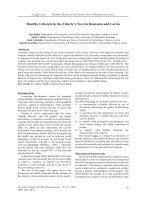abel's theorem in problems and solutions - v.b. alekseev
Bạn đang xem bản rút gọn của tài liệu. Xem và tải ngay bản đầy đủ của tài liệu tại đây (7.44 MB, 285 trang )
TeAM
YYePG
Digitally signed by TeAM YYePG
DN: cn=TeAM YYePG, c=US,
o=TeAM YYePG, ou=TeAM
YYePG, email=
Reason: I attest to the accuracy
and integrity of this document
Date: 2005.01.23 16:28:19 +08'00'
ABEL’S THEOREM IN PROBLEMS AND SOLUTIONS
This page intentionally left blank
Abel’s Theorem
in Problems and Solutions
Based on the lectures of Professor V.I. Arnold
by
V.B. Alekseev
Moscow State University,
Moscow, Russia
KLUWER ACADEMIC PUBLISHERS
NEW YORK, BOSTON, DORDRECHT, LONDON, MOSCOW
eBook ISBN: 1-4020-2187-9
Print ISBN: 1-4020-2186-0
©2004 Springer Science + Business Media, Inc.
Print ©2004 Kluwer Academic Publishers
All rights reserved
No part of this eBook may be reproduced or transmitted in any form or by any means, electronic,
mechanical, recording, or otherwise, without written consent from the Publisher
Created in the United States of America
Visit Springer's eBookstore at:
and the Springer Global Website Online at:
Dordrecht
Contents
Preface for the English edition by V.I. Arnold
Preface
Introduction
1
Groups
1.1
1.2
1.3
1.4
1.5
1.6
1.7
1.8
1.9
1.10
1.11
1.12
1.13
1.14
1.15
Examples
Groups of transformations
Groups
Cyclic groups
Isomorphisms
Subgroups
Direct product
Cosets. Lagrange’s theorem
Internal automorphisms
Normal subgroups
Quotient groups
Commutant
Homomorphisms
Soluble groups
Permutations
ix
xiii
1
9
9
13
14
18
19
21
23
24
26
28
29
31
33
38
40
2.1
2.2
2.3
2.4
Fields and polynomials
The field of complex numbers
Uniqueness of the field of complex
numbers
Geometrical descriptions of the
complex numbers
46
51
55
2
The complex numbers
45
v
58
vi
2.5
2.6
2.7
2.8
2.9
2.10
2.11
2.12
2.13
2.14
The trigonometric form of the complex numbers
Continuity
Continuous curves
Images of curves: the basic theorem
of the algebra of complex numbers
The Riemann surface of the function
The Riemann surfaces of more
complicated functions
Functions representable by radicals
Monodromy groups of multi-valued
functions
Monodromy groups of functions
representable by radicals
The Abel theorem
60
62
65
71
74
83
90
96
99
100
3
Hints, Solutions, and Answers
3.1
3.2
Problems of Chapter 1
Problems of Chapter 2
Drawings of Riemann surfaces (F. Aicardi)
105
105
148
209
Appendix by A. Khovanskii: Solvability of equations
by explicit formulae
A.1
A.2
A.3
A.4
A.5
A.6
A.7
A.8
A.9
A.10
A.10.1
A.10.2
Explicit solvability of equations
Liouville’s theory
Picard–Vessiot’s theory
Topological obstructions for
the representation of functions
by quadratures
Monodromy group
Obstructions for the representability
of functions by quadratures
Solvability of algebraic equations
The monodromy pair
Mapping of the semi-plane to a
polygon bounded by arcs of circles
Application of the symmetry principle
Almost soluble groups of homographic
and conformal mappings
221
222
224
228
230
231
232
233
234
235
237
237
238
A.10.3 The integrable case
A.11 Topological obstructions for the
solvability of differential equations
A.11.1
The monodromy group of a linear
differential equation and its relation
with the Galois group
A.11.2 Systems of differential equations of Fuchs’
type with small coefficients
A.12 Algebraic functions of several
variables
A.13 Functions of several complex variables
representable by quadratures and
generalized quadratures
A.14
A.15
Topological obstructions for the
representability by quadratures
of functions of several variables
A.16
Topological obstruction for the
solvability of the holonomic systems
of linear differential equations
A.16.1 The monodromy group of a holonomic
system of linear differential equations
A.16.2
Holonomic systems of equations of linear
differential equations with small coefficients
Bibliography
Appendix by V.I. Arnold
Index
vii
242
244
244
246
247
250
252
256
257
257
258
261
265
267
This page intentionally left blank
Preface to the English edition
by V.I. Arnold
Abel’s Theorem, claiming that there exists no finite combinations of rad-
icals and rational functions solving the generic algebraic equation of de-
gree 5 (or higher than 5), is one of the first and the most important
impossibility results in mathematics.
I had given to Moscow High School children in 1963–1964 a (half
year long) course of lectures, containing the topological proof of the Abel
theorem.
Starting from the definition of complex numbers and from geometry,
the students were led to Riemannian surfaces in a sequence of elementary
problems. Next came the basic topological notions, such as the funda-
mental group, coverings, ramified coverings, their monodromies, braids,
etc
These geometrical and topological studies implied such elementary
general notions as the transformations groups and group homomorphisms,
kernels, exact sequences, and relativistic ideas. The normal subgroups
appeared as those subgroups which are relativistically invariant, that is,
do not depend on the choice of the coordinate frame, represented in this
case as a numbering or labelling of the group elements.
The regular polyhedra symmetry groups, seen from this point of view,
had led the pupils to the five Kepler’s cubes, inscribed into the dodeca-
hedron. The 12 edges of each of these cubes are the diagonals of the 12
faces of the dodecahedron.
Kepler had invented these cubes in his Harmonia Mundi to describe
the distances of the planets from the Sun. I had used them to obtain the
natural isomorphism between the dodecahedron rotations group and the
group of the 60 even permutations of 5 elements (being the Kepler cubes).
This elementary theory of regular polyhedra provides the non-solubility
proof of the 5 elements permutation group: it can not be constructed
ix
x
from the commutative groups by a finite sequence of the extensions with
commutative kernels.
The situation is quite different for the permutation groups of less
than five elements, which are soluble (and responsible for the solvability
of the equations of degree smaller than 5). This solubility depends on the
inscription of two tetrahedra inside the cube (similar to the inscription
of the 5 Kepler cubes inside the dodecahedron and mentioned also by
Kepler).
The absence of the non-trivial relativistically invariant symmetry sub-
groups of the group of rotations of the dodecahedron is an easy result of
elementary geometry. Combining these High School geometry arguments
with the preceding topological study of the monodromies of the ramified
coverings, one immediately obtains the Abel Theorem topological proof,
the monodromy group of any finite combination of the radicals being sol-
uble, since the radical monodromy is a cyclical commutative group, whilst
the monodromy of the algebraic function
defined by the quintic equa-
tion is the non-soluble group of the 120 permutations of
the 5 roots.
This theory provides more than the Abel Theorem. It shows that
the insolvability argument is topological. Namely, no function having
the same topological branching type as is representable as a finite
combination of the rational functions and of the radicals.
I hope that my topological proof of this generalized Abel Theorem
opens the way to many topological insolvability results. For instance,
one should prove the impossibility of representing the generic abelian
integrals of genus higher than zero as functions topologically equivalent
to the elementary functions.
I attributed to Abel the statements that neither the generic elliptic
integrals nor the generic elliptic functions (which are inverse functions of
these integrals) are topologically equivalent to any elementary function.
I thought that Abel was already aware of these topological results
and that their absence in the published papers was, rather, owed to the
underestimation of his great works by the Paris Academy of Sciences
(where his manuscript had been either lost or hidden by Cauchy).
My 1964 lectures had been published in 1976 by one of the pupils of
High School audience, V.B. Alekseev. He has somewhere algebraized my
geometrical lectures.
Some of the topological ideas of my course had been developed by A.G.
Khovanskii, who had thus proved some new results on the insolvability
xi
of the differential equations. Unfortunately, the topological insolvability
proofs are still missing in his theory (as well as in the Poincaré theory of
the absence of the holomorphic first integral and in many other insolv-
ability problems of differential equations theory).
I hope that the description of these ideas in the present translation
of Alekseev’s book will help the English reading audience to participate
in the development of this new topological insolvability theory, started
with the topological proof of the Abel Theorem and involving, say, the
topologically non elementary nature of the abelian integrals as well as the
topological non-equivalence to the integrals combinations of the compli-
cated differential equations solutions.
The combinatory study of the Kepler cubes, used in the Abel the-
orem’s proof, is also the starting point of the development of the theory
of finite groups. For instance, the five Kepler cubes depend on the 5
Hamilton subgroups of the projective version of the group of
matrices of order 2 whose elements are residues modulo 5.
A Hamilton subgroup consists of 8 elements and is isomorphic to the
group of the quaternionics units.
The peculiar geometry of the finite groups includes their squaring
monads, which are the oriented graphs whose vertices are the group ele-
ments and whose edges connect every element directly to its square.
The monads theory leads to the unexpected Riemannian
surfaces (including the monads as subgraphs), relating Kepler’s cubes to
the peculiarities of the geometry of elliptic curves.
The extension of the Hamilton subgroups and of Kepler’s
cubes leads to the extended four colour problem (for the genus one toroidal
surface of an elliptic curve), the 14 Hamilton subgroups providing the
proof of the 7 colours necessity for the regular colouring of maps of a
toroidal surface).
I hope that these recent theories will be developed further by the
readers of this book.
V. Arnold
This page intentionally left blank
Preface
In high school algebraic equations in one unknown of first and second
degree are studied in detail. One learns that for solving these equations
there exist general formulae expressing their roots in terms of the co-
efficients by means of arithmetic operations and of radicals. But very
few students know whether similar formulae do exist for solving algebraic
equations of higher order. In fact, such formulae also exist for equations
of the third and fourth degree. We shall illustrate the methods for sol-
ving these equations in the introduction. Nevertheless, if one considers
the generic equation in one unknown of degree higher than four one finds
that it is not solvable by radicals: there exist no formulae expressing the
roots of these equations in terms of their coefficients by means of arith-
metic operations and of radicals. This is exactly the statement of the
Abel theorem.
One of the aims of this book is to make known this theorem. Here we
will not consider in detail the results obtained a bit later by the French
mathematician Évariste Galois. He considered some special algebraic
equation, i.e., having particular numbers as coefficients, and for these
equations found the conditions under which the roots are representable
in terms of the coefficients by means of algebraic equations and radicals
1
.
From the general Galois results one can, in particular, also deduce the
Abel theorem. But in this book we proceed in the opposite direction:
this will allow the reader to learn two very important branches of modern
mathematics: group theory and the theory of functions of one complex
variable. The reader will be told what is a group (in mathematics), a
field, and which properties they possess. He will also learn what the
complex numbers are and why they are defined in such a manner and not
1
To those who wish to learn the Galois results we recommend the books: Postnikov
M.M., Boron L.F., Galois E., Fundamentals of Galois Theory, (Nordhoff: Groningen),
(1962); Van der Waerden B.L., Artin E., Noether E., Algebra, (Ungar: New York,
N.Y.) (1970).
xiii
xiv
otherwise. He will learn what a Riemann surface is and of what the ‘basic
theorem of the complex numbers algebra’ consists.
The author will accompany the reader along this path, but he will
also give him the possibility of testing his own forces. For this purpose
he will propose to the reader a large number of problems. The problems
are posed directly within the text, so representing an essential part of
it. The problems are labelled by increasing numbers in bold figures.
Whenever the problem might be too difficult for the reader, the chapter
‘Hint, Solutions, and Answers’ will help him.
The book contains many notions which may be new to the reader.
To help him in orienting himself amongst these new notions we put at
the end of the book an alphabetic index of notions, indicating the pages
where their definitions are to be found.
The proof of the Abel theorem presented in this book was presented
by professor Vladimir Igorevich Arnold during his lectures to the students
of the la 11th course of the physics-mathematics school of the State Uni-
versity of Moscow in the years 1963–64. The author of this book, who
at that time was one of the pupils of that class, during the years 1970–
71 organized for the pupils of that school a special seminar dedicated to
the proof of the Abel theorem. This book consists of the material col-
lected during these activities. The author is very grateful to V.I. Arnold
for having made a series of important remarks during the editing of the
manuscript.
V.B. Alekseev
Introduction
We begin this book by examining the problem of solving algebraic equa-
tions in one variable from the first to the fourth degree. Methods for
solving equations of first and second degree were already known by the
ancient mathematicians, whereas the methods of solution of algebraic
equations of third and fourth degree were invented only in the XVI cen-
tury.
An equation of the type:
in which
2
, is called the generic algebraic equation
of degree
in
one variable.
For we obtain the linear equation
This equation has the unique solution
for any value of the coefficients.
For we obtain the quadratic equation
(in place of we write as learnt in school). Dividing both
members of this equation by and putting and we obtain
the reduced equation
2
For the time being the coefficients may be considered to be arbitrary
real numbers.
1
2
After some transformations we obtain
In high school one considers only the case Indeed, if
then one says that Eq. (1) cannot be satisfied and that Eq.
(2) has no real roots. In order to avoid these exclusions, in what follows
we shall not restrict ourselves to algebraic equations over the field of the
real numbers, but we will consider them over the wider field of complex
numbers.
We shall examine complex numbers in greater detail (together with
their definition) in Chapter 2. In the meantime it is sufficient for the
reader to know, or to accept as true, the following propositions about the
complex numbers:
the set of complex numbers is an extension of the set of real num-
bers, i.e., the real numbers are contained in the complex numbers,
just as, for example, the integer numbers are contained in the real
numbers;
the complex numbers may be added, subtracted, multiplied, di-
vided, raised to a natural power; moreover, all these operations
possess all the basic properties of the corresponding operations on
the real numbers;
if is a complex number different from zero, and is a natural
number, then there exist exactly roots of degree of i.e.,
complex numbers such that For we have
If and are square roots of the number then
1.
2.
3.
In the following we shall be interested not only in complex roots of
equations as well as in the real ones, but also we will consider arbitrary
complex numbers as coefficients of these equations. Hence, the arguments
previously expounded about linear and quadratic equations remain true
by virtue of what results from property 2 of complex numbers.
Let us continue to study the quadratic equation. In the field of com-
plex numbers for any value of and Eq. (2) is equivalent to
Introduction
3
where by is indicated whichever of the defined values of the
square root. In so doing:
Going back to the coefficients we obtain
For what follows we need to recall two properties related to the equa-
tions of second degree.
Viète’s Theorem
3
: The complex numbers and are the roots of
the equation if and only if and
Indeed, if and are roots of the equation then
Eq. (3) is satisfied, from which and
Conversely, if and then, substituting and
in the equation by their expressions in terms of
and we obtain
and therefore and are roots of the equation
The quadratic trinomial is a perfect square, i.e.,
for some complex number if and only if the roots of the equation
coincide (they must be both equal to This happens
if and only if (see formula (4)). The expression
is called the discriminant of the quadratic trinomial.
We consider now the reduced cubic equation
The generic equation of third degree is reduced to Eq. (5) by dividing
by After the substitution (where will be chosen later) we
obtain
3
François Viète (1540-1603) was a French mathematician.
1.
2.
4
Removing the brackets and collecting the terms of the same degree in
we obtain the equation
The coefficient of in this equation is equal to Therefore if we
put after substituting we transform the equation
into:
where and are some polynomials in and
Let be a root of Eq. (6). Representing it in the form
(where and are temporarily unknown) we obtain
and
We check whether it is possible to impose that and satisfy
In this case we obtain two equations for and
By Viète’s theorem, for any such and (which may be complex)
indeed exist, and they are the roots of the equation
If we take such (still unknown) and then Eq. (7) is transformed into
Raising either terms of the equation to the third power, and
comparing the obtained equation with Eq. (8), we have
Introduction
5
By Viète’s theorem and are the roots of the equation
In this way
where again indicates one defined value of the square
root. Hence the roots of Eq. (6) are expressed by the formula
in which for each of the three values of the first cubic root
4
one must
take the corresponding value of the second, in such a way that condition
be satisfied.
The obtained formula is named Cardano’s formula
5
. Substituting in
this formula and by their expressions in terms of and subtracting
we obtain the formula for Eq. (5). After the transformations
we obtain the formula for the roots of the
generic equation of third degree.
Now we examine the reduced equation of fourth degree
(the generic equation is reduced to the previous one by dividing by
By making the change of variable similarly to the change
made in the case of the equation of third degree, we transform Eq. (9)
into
where and are some polynomials in
We shall solve Eq. (10) by a method called Ferrari’s method
6
. We
transform the left term of Eq. (10) in the following way:
4
See the aforementioned Property 3 of complex numbers.
5
G. Cardano (1501-1576) was an Italian mathematician.
6
L. Ferrari (1522–1565) was an Italian mathematician, a pupil of Cardano.
6
and
where is an arbitrary number. We try now to determine such that
the polynomial of second degree in
within square brackets becomes a perfect square. As was noticed above,
in order for it to be a perfect square it is necessary and sufficient that the
discriminant of this polynomial vanish, i.e.,
Eliminating the brackets, to find we obtain an equation of third degree
which we are able to solve. If in place of we put one of the roots
of Eq. (12) then the expression in the square brackets of (11) will be a
perfect square. In this case the left member of Eq. (11) is a difference of
squares and therefore it can be written as the product of two polynomials
of second degree in After that it remains to solve the two equations of
second degree obtained.
Hence the equation of fourth degree can always be solved. Moreover,
as in the case of the third order, it is possible to obtain a formula ex-
pressing the roots of the generic equation of fourth order in terms of
the coefficients of the equation by means of the operations of addition,
subtraction, multiplication, division, raising to a natural power, and ex-
tracting a root of natural degree.
For a long time mathematicians tried to find a method of solution by
radicals of the generic equation of fifth order. But in 1824 the Norwe-
gian mathematician Niels Henrik Abel (1802–1829) proved the following
theorem.
Abel’s Theorem. The generic algebraic equation of degree higher than
four is not solvable by radicals, i.e., formulæ do not exist for expressing
roots of a generic equation of degree higher than four in terms of its co-
efficients by means of operations of addition, subtraction, multiplication,
division, raising to a natural power, and extraction of a root of natural
degree.
Introduction
7
We will be able to prove this theorem at the end of this book. But
for this we need some mathematical notions, such as those of group,
so-luble group, function of a complex variable, Riemann surface, etc
The reader will become familiar with all these and other mathematical
instruments after reading what follows in the forthcoming pages of this
book. We start by examining the notion of group, a very important notion
in mathematics.
This page intentionally left blank
Chapter 1
Groups
1.1
Examples
In arithmetic we have already met operations which put two given num-
bers in correspondence with a third. Thus, the addition puts the pair
(3,5) in correspondence with the number 8 and the pair (2,2) with the
number 4. Also the operation of subtraction if considered inside the set
of all integer numbers, puts every pair of integers in correspondence with
an integer: in this case, however, the order of numbers in the pair is im-
portant. Indeed, subtraction puts the pair (5,3) in correspondence with
the number 2, whereas the pair (3,5) with the number –2. The pairs (5,3)
and (3,5) thus have to be considered as different.
When the order of elements is specified a pair is said to be ordered.
D
EFINITION.
Let M be a set of
elements
of
arbitrary nature.
If
every
ordered pair of elements of M is put into correspondence with an element
of M we say that in
M
a binary operation is defined.
For example, the addition in the set of natural numbers and the sub-
traction in the set of integer numbers are binary operations. The subtrac-
tion is not a binary operation in the set of natural numbers because, for
example, it cannot put the pair (3,5) in correspondence with any natural
number.
1.
Consider the following operations: a) addition; b) subtraction; c)
multiplication; in the following sets: 1) of all even natural numbers; 2)
of all odd natural numbers; 3) of all negative integer numbers. In which
cases does one obtain a binary operation
1
?
1
Part of the problems proposed in the sequel has a practical character and is aimed
9









